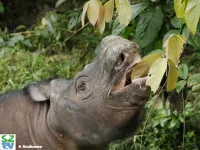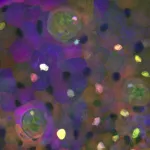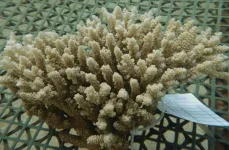Nanobodies inhibit SARS-CoV-2 infection
Australian researchers have identified neutralising nanobodies that block the SARS-CoV-2 virus from entering cells in preclinical models
2021-04-26
(Press-News.org) Australian researchers have identified neutralising nanobodies that block the SARS-CoV-2 virus from entering cells in preclinical models.
The discovery paves the way for further investigations into nanobody-based treatments for COVID-19.
Published in PNAS, the research is part of a consortium-led effort, bringing together the expertise of Australian academic leaders in infectious diseases and antibody therapeutics at WEHI, the Doherty Institute and the Kirby Institute.
At a glance
Researchers have identified nanobodies that effectively blocked the SARS-CoV-2 virus from entering cells in pre-clinical models of COVID-19 infection.
Nanobodies - which are tiny immune proteins - could provide an alternative to conventional antibody treatments for COVID-19.
By mapping nanobodies, the research team was able to identify a nanobody that recognised the SARS-CoV-2 virus, including emerging global variants of concern. The nanobody also recognised the original SARS-CoV virus (which causes SARS), indicating it may provide cross-protection against these two human coronaviruses.
Using alpaca 'nanobodies' to block COVID-19 infection
Antibodies are key infection-fighting proteins in our immune system. An important aspect of antibodies is that they bind tightly and specifically to another protein.
Antibody-based therapies, or 'biologics', harness this property of antibodies, enabling them to bind to a protein involved in disease.
Nanobodies are unique antibodies - tiny immune proteins - produced naturally by alpacas in response to infection.
As part of the research, a group of alpacas in regional Victoria were immunised with a synthetic, non-infectious part of the SARS-CoV-2 'spike' protein to enable them to generate nanobodies against the SARS-CoV-2 virus.
WEHI Associate Professor Wai-Hong Tham, who led the research, said the establishment of a nanobody platform at WEHI allowed an agile response for the development of antibody-based therapies against COVID-19.
"The synthetic spike protein is not infectious and does not cause the alpacas to develop disease - but it allows the alpacas to develop nanobodies," she said.
"We can then extract the gene sequences encoding the nanobodies and use this to produce millions of types of nanobodies in the laboratory, and then select the ones that best bind to the spike protein."
Associate Professor Tham said the leading nanobodies that block virus entry were then combined into a 'nanobody cocktail'.
"By combining the two leading nanobodies into this nanobody cocktail, we were able to test its effectiveness at blocking SARS-CoV-2 from entering cells and reducing viral loads in preclinical models," she said.
Mapping nanobody binding
ANSTO's Australian Synchrotron and the Monash Ramaciotti Centre for Cryo-Electron Microscopy were critical resources in the project, allowing the research team to map how the nanobodies bound to the spike protein and how this impacted the virus' ability to bind to its human receptor.
Hariprasad Venugopal, Senior Microscopist from the Monash Ramaciotti Centre for Cryo-Electron Microscopy, said the study highlighted the importance of open-access to high-end Cryo-EM facilities.
"We were able to directly image and map the neutralising interaction of the nanobodies with the spike protein using Cryo-EM at near atomic resolution," Mr Venugopal said.
"Cryo-EM has been an important drug discovery tool in the global response to the COVID-19 pandemic."
By mapping the nanobodies, the research team was able to identify a nanobody that recognised the SARS-CoV-2 virus, including emerging global variants of concern. The nanobody was also effective against the original SARS virus (SARS-CoV), indicating it may provide cross-protection against these two globally significant human coronaviruses.
"In the wake of COVID-19, there is a lot of discussion about pandemic preparedness. Nanobodies that are able to bind to other human beta-coronaviruses - including SARS-CoV-2, SARS-CoV and MERS - could prove effective against future coronaviruses as well," Associate Professor Tham said.
INFORMATION:
This work was made possible with funding from the Medical Research Future Fund, the Hengyi Group and the Victorian Government.
ELSE PRESS RELEASES FROM THIS DATE:
2021-04-26
DALLAS, April 26, 2021 -- The hormonal therapies used to treat many breast and prostate cancers raise the risk of a heart attack and stroke, and patients should be monitored regularly and receive treatment to reduce risk and detect problems as they occur, according to a new American Heart Association scientific statement, published today in the Association's journal Circulation: Genomic and Precision Medicine.
"The statement provides data on the risks of each type of hormonal therapy so clinicians can use it as a guide to help manage cardiovascular risks during cancer treatment," said Tochi M. Okwuosa, D.O., FAHA, chair of the scientific statement writing group, an associate professor of ...
2021-04-26
A study led by researchers at the Centre for Palaeogenetics in Stockholm shows that the last remaining populations of the Sumatran rhinoceros display surprisingly low levels of inbreeding. The researchers sequenced the genomes from 21 modern and historical rhinoceros' specimens, which enabled them to investigate the genetic health in rhinos living today as well as a population that recently became extinct. These findings are published today in the journal Nature Communications.
With less than 100 individuals remaining, the Sumatran rhinoceros is one of the most endangered mammal species in the world. Recent reports of health issues and low fecundity have raised fears that the remaining populations are suffering from inbreeding problems. ...
2021-04-26
SILVER SPRING, Md.--A new Australian study reveals that changes in lifestyle patterns were longitudinally associated with concurrent changes in body mass index (BMI) z scores, and maternal pre-pregnancy BMI, maternal dietary patterns and television viewing time are significant determinants, according to a paper published online in Obesity, The Obesity Society's (TOS) flagship journal. This is the first study that used multi-trajectory modeling to examine the longitudinal relationship between concurrent changes in lifestyle patterns and BMI z scores in early childhood.
"The findings will inform early childhood obesity prevention intervention ...
2021-04-26
A recent study provides insights on the COVID-19 pandemic's effects on employment, anxiety, and financial distress among women who have gynecologic cancer and low income. The findings are published early online in CANCER, a peer-reviewed journal of the American Cancer Society.
For the study, Y. Stefanie Chen, MD, of Weill Cornell Medicine in New York City, and her colleagues conducted telephone interviews with 100 women with gynecologic cancer living in New York City who were covered by Medicaid health insurance.
Among the major findings:
31 percent of patients reported being employed prior to the pandemic, and 21 percent had a change in employment status due to the pandemic.
50 percent ...
2021-04-26
A majority of gay and bisexual Generation Z teenage boys report being out to their parents, part of an uptick in coming out among young people that researchers have noted in recent decades, according to research published by the American Psychological Association. However, stigma and religious beliefs still prevent some young people from disclosing their sexual identity.
This study offers a glimpse into the coming out practices of Generation Z, those born between 1998 and 2010, a group that researchers are only beginning to study.
"This study is encouraging in that it shows that many teens, including those under 18 years old, are comfortable with their sexuality," said lead author David A. Moskowitz, PhD, assistant professor of medical ...
2021-04-26
KANSAS CITY, MO--One of the evolutionary disadvantages for mammals, relative to other vertebrates like fish and chickens, is the inability to regenerate sensory hair cells. The inner hair cells in our ears are responsible for transforming sound vibrations and gravitational forces into electrical signals, which we need to detect sound and maintain balance and spatial orientation. Certain insults, such as exposure to noise, antibiotics, or age, cause inner ear hair cells to die off, which leads to hearing loss and vestibular defects, a condition reported by 15% of the US adult population. In addition, the ion composition of the fluid surrounding the hair cells needs to be tightly controlled, otherwise ...
2021-04-26
Protecting long-term care residents from outbreaks requires different infrastructure, proper staffing conditions and a culture of quality assurance, researchers have found.
The experts further determined that designing smaller, more homelike spaces would minimize the spread of viruses while promoting better health and quality of life for residents.
"Community outbreaks and lack of personal protective equipment were the primary drivers of outbreak occurrence in long-term care homes, and the built environment was the major determinant of outbreak severity," said George Heckman, a professor in Waterloo's School of Public Health and Health Systems and Schlegel Research Chair in Geriatric Medicine with the Research Institute for Aging.
"We need to distinguish ...
2021-04-26
MUNICH -- Rewilding--a hands-off approach to restoring and protecting biodiversity--is increasingly employed across the globe to combat the environmental footprint of rapid urbanization and intensive farming. The recent reintroduction of grey wolves in Yellowstone, America's first national park, is regarded as one of the most successful rewilding efforts, having reinvigorated an ecosystem that had been destabilized by the removal of large predators.
However, successful attempts to rewild the landscape hinge on more than just the reintroduction of a plant or animal species, they also require that geography and geology be taken into account, according to new research from the University of Amsterdam and the Dutch State Forestry Service.
It is the landscape that ultimately ...
2021-04-26
MUNICH -- The first emergence and persistence of continental crust on Earth during the Archaean (4 billion to 2.5 billion years ago) has important implications for plate tectonics, ocean chemistry, and biological evolution, and it happened about half a billion years earlier than previously thought, according to new research being presented at the EGU General Assembly 2021.
Once land becomes established through dynamic processes like plate tectonics, it begins to weather and add crucial minerals and nutrients to the ocean. A record of these nutrients is preserved in the ancient rock record. Previous research used strontium isotopes in marine carbonates, but these rocks are usually scarce ...
2021-04-26
Researchers have successfully grown cells from the stony coral, Acropora tenuis, in petri dishes
The cell lines were created by separating out cells from coral larvae, which then developed into eight distinct cell types
Seven out of eight cell types were stable and could grow indefinitely, remaining viable even after freezing
Some of the cell types represented endoderm-like cells, and could therefore shed light on how coral interacts with photosynthesizing algae and how bleaching occurs
The cell lines could be used in many avenues ...
LAST 30 PRESS RELEASES:
[Press-News.org] Nanobodies inhibit SARS-CoV-2 infection
Australian researchers have identified neutralising nanobodies that block the SARS-CoV-2 virus from entering cells in preclinical models




